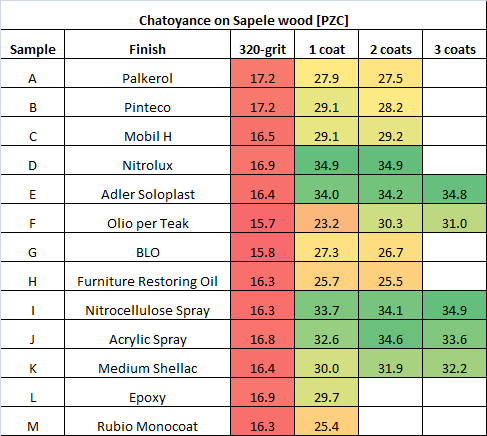This set of tests is aimed at understanding the effect of different finishes on Sapele.
A set of 13 consecutive veneer sheets (from “A” to “M”) were employed; these consecutive layers of the initial log and start from very similar PZC values. All samples were sanded to 320-grit.
A special thanks goes to company Seralvo for providing the veneer samples and Veleca for supporting us with finish samples.
We tested these finishes:
Sample A: Veleca Palkerol (water based anionic polyurethane – floor finish)
Sample B: Veleca Pinteco (acrylic emulsion – outdoor finish)
Sample C: Veleca Mobil H (water based acrylic – furniture finish)
Sample D: Veleca Nitrolux (thinner based ketone resin – classic furniture finish)
Sample E: Adler Soloplast (alkyd based finish)
Sample F: Veleca Olio per Teak (Tung oil based – exotic wood finish)
Sample G: Boiled Linseed Oil (BLO)
Sample H: Furniture restoring oil
Sample I: Nitrocellulose spray lacquer (NCL)
Sample J: Acrylic spray lacquer
Sample K: Blonde Dewaxed Shellac “Medium” (2 parts in 13 parts of Alcohol)
Sample L: Transparent epoxy resin
Sample M: Rubio Monocoat
Sample N: Impregnante CIPIR
It was concluded that:
1) Chatoyance is always increased by these clear coats, with values around and over 30 PZC reached in some cases
2) Nitrolux, Adler Soloplast and Nitrocellulose lacquer provide good results
3) All these “clear” finishes significantly darken the surface
Tables below summarize the results in terms of chatoyance (PZC):

Tables below summarize the results in terms of brightness (fraction of white paper brightness):

Pictures below show the results:













